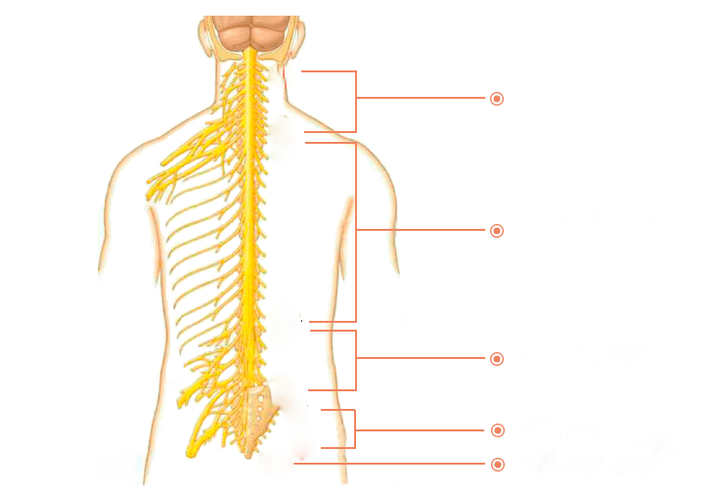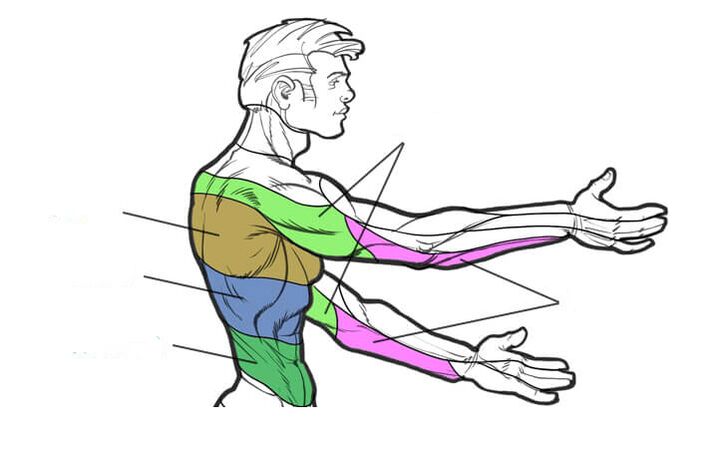The thoracic spine has a distinctive feature - the ribs join it. Because of this, it has less mobility than the neck and lower back. Consequently, osteochondrosis in the thoracic region develops less often according to the principle: "Less mobility - less wear and tear". But it develops less often - this does not mean that it flows more easily. And that's actually it. It's about chest pain. Since the pain zone of theSince the thoracic spine coincides with the zone of the heart, the symptoms are often confused with angina pectoris or a heart attack. No wonder thoracic osteochondrosis is said to be a "chameleon". After all, he can not only fake heart disease, but also a disease of the lungs, liver, stomach, gallbladder or pancreas. And here you can not make a mistake and miss a heart attack or other serious illness, for example, pathology of the mammary glands in women. Mistakes like this are costly, even if it works out in the end. After all, this can "drive" a person into severe stress. That is why it is very important to find an experienced and knowledgeable doctor who will understand everything and distinguish the symptoms of thoracic osteochondrosis from other pathologies. Symptoms of osteochondrosis of the thoracic region become normaldivided into two categories - radicular and reflex.
radical symptoms
They arise as a result of the effect on the nerves exiting the spine.
spinal nerves

Many nerves come out of the spine. They are called spinal nerves. Each of these nerves gradually branches out, following a specific area of the body with clearly defined boundaries. This area is called the zone of segmental innervation. Each vertebra, disc, nerve and zone is numbered strictly corresponding to one another. When the nerve is affected, the symptoms appear in the zone of segmental innervation corresponding to that nerve, and not anywhere - anywhere.
Radical symptoms include:
- decrease or loss of reflexes;
- violation of sensitivity;
- muscle weakness;
- core pain.
Innervation zones of the thoracic segments
Osteochondrosis D1–D2- causes pain in the shoulder, collarbone and armpits.

Osteochondrosis D3–D6- Causes pain, belt character in the upper part of the chest. Simulates pain in the heart, an attack of angina pectoris. In women, it causes pain in the mammary glands.
Osteochondrosis D7-D8- causes belt pain at the level of the solar plexus. Simulates pain in the stomach, liver, gallbladder or pancreas. Reduces upper abdominal reflexes.
Osteochondrosis D9-D10- causes pain in the hypochondrium and upper abdomen. Sometimes it mimics the so-called "acute" abdomen - a sharp pain in the abdomen. Decreases middle abdominal reflexes.
Osteochondrosis D11–D12- causes pain in the groin area. Simulates pain in women's diseases, appendicitis, intestinal diseases. Reduces lower abdominal reflexes.
reflex symptoms
Unlike radicular reflex symptoms, there are no clear boundaries. These can be: difficulty breathing, lack of air, pain when breathing in and out, chills and "goosebumps" on the skin, intercostal neuralgia, girdle pain in the chest. Dyspepsia is often noted - appetite worsens, nausea, heartburn, flatulence and stool disorders appear. Because of pain, there is a disturbance in sleep, sleep disturbances and a feeling of not having enough sleep. It is difficult to move, especially in the morning. The coordination of movements is disturbed – this is reflected in the gait. General weakness, weakness. Violations in the sexualArea Irritability Fatigue easily There are several types of pain Pressing chest pain Pain between the shoulder blades Pain in the hypochondrium Pain when raising your arms Pain when bending or standing up Pain between the shoulder blades In general, pain can cause painin osteochondrosis of the chest region can be divided into two types.
dorsalgia- moderately expressed persistent pain in the back and chest with periods of intensification and dulling.
Dorsago- acute pain "lumbago" in this area.
- Symptoms of osteochondrosis of the chest region depend on the stage of osteochondrosis.
- They are made worse by bending over or trying to sit up.
- Symptoms often appear after 35-45 years.
- It occurs about 3 times more often in women than in men.
You have of course noticed that the radicular symptoms are well defined and the reflex symptoms are very vague and non-specific. And as you know, anything that isn't clearly defined serves as a convenient cover for professional helplessness. This applies, among other things, to reflex symptoms and such a popular term among doctors as "age-related changes". Surely many of you know the situation when the doctor explained the problem in terms of "reflex" or "age-related" processes. Most people believe at such momentsrightly so that the doctor simply cannot figure out what is happening and tries to cloak his incompetence in the haze of these "magic words".
There used to be a popular phrase: "Every accident has a name, surname and position. "Each disease has its own unique set of symptoms. And the doctor's duty is to know them well. And then there will be no need to let in fog and blame everything on osteochondrosis of the chest region. Now you understand the importance of finding an experienced and knowledgeable doctor. Both the correct diagnosis and good treatment results depend on this.
The diagnosis is the key to the right treatment
To date, there are a number of modern methods of hardware diagnostics of osteochondrosis. The most accurate of these are MRI and CT. However, the main method is still clinical diagnostics - in this, an experienced doctor compares data from at least three sources - from patient complaints, MRI results and the symptoms he found during the examination. This allows you to make the most accurate diagnosis and create an effective individual treatment program.
treatment
As you can understand, osteochondrosis is a real "tangle" of symptoms, the unraveling of which the doctor will save you from pain and torment. But it is not possible to eliminate changes in vertebrae and intervertebral discs. Therefore, the words "treatment of osteochondrosis" must be correctbe understood. If you are interested in getting rid of pain and other ailments, then yes - it is quite possible. And if you are having an academic discussion on the subject of returning the vertebrae and intervertebral discs to their original appearance, "like a newbornchild", then no, the past cannot be brought back. You have to be realistic, then you will not fall for scammers.
Don't fall for scammers!
It is impossible to restore the vertebrae and discs to their original appearance!
What is the main treatment method?
Gentle manual therapy is the main type of treatment of osteochondrosis of the chest region. It's like an antibiotic for pneumonia - you can't do without it. Other types - massage, medication, physical and exercise therapy - are supportive.
How does gentle manual therapy work?
The nutrition of the intervertebral discs is directly related to the muscles surrounding the spine. In addition, the back muscles themselves are one of the constituent causes of pain in osteochondrosis of the chest region. Gentle manual therapy is a special method that allows you to return muscles to their natural physiology, eliminate spasms and muscle tension, and improve intervertebral disc nutrition.
The intervertebral discs are the only part of the body that does not have blood vessels and is nourished by the proper functioning of the muscles.
In addition, when treating with the hands, the chiropractor can:
- relieve and properly distribute the affected vertebrae and discs;
- relax muscles and help them return to normal;
In order to:
- save the patient from clamps;
- improve disk performance;
- restore the motor functions of the body;
- normalizes blood circulation.
A handshake mobilizes the inner forces of the body and sets self-healing mechanisms in motion.
The treatment is absolutely safe.
prevention
To avoid relapses, create comfortable conditions for yourself for sleeping and working. Watch your weight and eat right. Maintain your physical activity. But the main thing is not to neglect your health and not save on it. Don't let things take their course. After recovery, try to do at least one maintenance session of gentle manual therapy every three to six months — this reduces risk factors. Do not forget that neglected osteochondrosis leads to complications - protrusion and herniated disc. Remember: you need your health first!
Ongoing osteochondrosis leads to complications - protrusion and herniated disc.















































